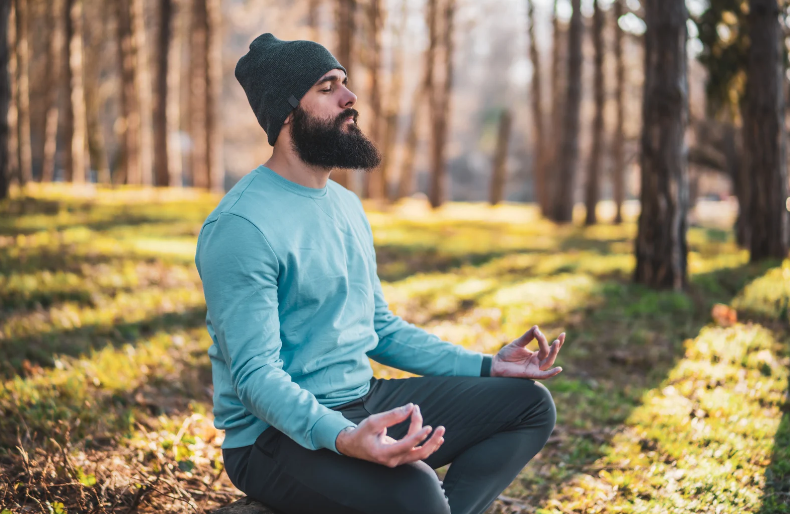The word "meditation" is likely to conjure up a mental image of a cross-legged person sitting still in a quiet, peaceful room. While this is the method of choice for many who meditate, others choose a more active route to mindfulness. It's called walking meditation, and by doing it, you get to enjoy the benefits of walking (health and endurance) and meditation (awareness and mindfulness) simultaneously. Think of it as Zen and the art of multitasking.
Meditation of any type is simply a process of developing greater awareness and mindfulness. One of the main benefits of cultivating these qualities is that you become more content and fulfilled—the desire to reach outside of yourself (to material things, for example) to feel content or fulfilled diminishes.
Besides this, there are other ways that meditation enhances health. It can also help:
- Relieve symptoms of illness. A study in the Journal of Alternative and Complementary Medicine found that an eight-week mindfulness meditation program resulted in effective and lasting reductions in symptoms for participants with chronic illnesses.
- Reduce high blood pressure. A year-long study, reported in the American Journal of Hypertension, showed that daily meditation lowered blood pressure more than relaxation techniques and information about lifestyle changes.
- Relieve stress and improve mood. A study published in the Annals of Behavioral Medicine reported that while both mindfulness meditation and other relaxation interventions can reduce distress and improve positive mood states, meditation may be more effective, especially at reducing distractive and ruminative thoughts and behaviors.
The premise is pretty simple. In walking meditation, the act of walking is your focus. Instead of thinking about your best friend’s birthday party that you just attended, you think about the present experience of walking.
There are several ways to practice walking meditation (three examples are outlined below). You can try each to see which you prefer, or you can alternate between them whenever you choose.
Walking Meditation #1: Focus on Your Feet
This technique is very simple, making it great for beginners. In this method, the focus is on your feet as they touch the ground. Your eyes are aimed a few steps ahead, and your mind is cleared of all thoughts and emotions extraneous to your keen awareness of each foot as you place it on the ground. With each step, you focus your attention only on the contact of your foot with the ground, and when your mind wanders from this focus, you bring it back to your foot. You could practice this form in your own backyard, or even indoors, as you can walk in a circle or back and forth in a line.
Walking Meditation #2: Focus on the Six Sensations
The second way to practice walking meditation is similar to the first, with a slight variation in focus. Once you've mastered the first technique, you'll be ready for a little more challenge. You focus only on the sensations of your feet, noticing the pattern of lifting, pushing, and dropping of your feet as you walk. Eventually, you will notice all six of the components of walking—raising, lifting, pushing, dropping, touching, and pressing. As you walk, you will notice that your mind will inevitably wander from this focus. The skill you work to develop is to refocus your awareness to the sensations of your feet, observing each component, each time it takes place. You can even chant the components softly as you walk. A walking meditation beginner would probably not be able to power walk, as the goal of walking meditation is to calm the mind, not send it spinning.
Walking Meditation #3: Focus on the Four Foundations
The third way to practice walking meditation is a little more complicated than the previous two, as there are several steps to follow:
To begin, stand solidly on the ground. Spend a minute or two taking note of how your body feels, and what mental state you are experiencing. As you begin your walk, practice focusing on each of the following four foundations, one at a time:
- Physical sensations. How does each part of your body feel? Start with the soles of your feet, and progress upward, relaxing each body part as you become aware of it. The point is not to think about why your shoulders are tense (let those thoughts go) but to simply relax them.
- Feelings. A feeling is your initial reaction to a sensation. When you hear a song on the radio that you don't like, your feeling is dislike or displeasure, for example. A feeling usually leads to an emotional response (in this example, anger or annoyance). Learning to separate your emotions from their feelings is a powerful tool. This foundation can help you to develop the power to observe a feeling for what it is, and, eventually, maintain more control over your emotional reaction to it.
- Mental and emotional states. Notice your state of mind. Is it calm or busy, cloudy or focused? Also notice your emotions as you experience them. Anger if someone comes too close while passing you, anxiety if you think of a huge project you need to finish, happiness at the sight of a puppy. Becoming aware of your present mental and emotional states strengthens your ability to be in and focus on the moment.
- Objects of consciousness. Inevitably, random thoughts will surface as you are trying to clear your mind and focus on these foundations. As you become aware of your emotions and thoughts, try to sort them into categories—thoughts to keep and thoughts to toss. Realize which thoughts lead to negative emotions and which lead to positive ones.
Once you have learned how to meditate while walking, you can practice it anytime you have the opportunity to walk, whether it's a block of time you set aside to exercise or a short jaunt across the parking lot. When you get really good, you can even use it on densely populated walks with lots of potential distractions.
Here are some tips that can help improve your experience:
- Choose the method that best suits your opportunity, and if it isn't feeling right, try another method.
- If you are practicing outdoors, stay away from high-traffic and heavily populated walking areas. Opt instead for a park or a walking trail.
- Give yourself about 20 minutes to practice for the first few times. If you feel it necessary, wear a watch with a timer, so your awareness isn't focused on the time.
- Practice safely. If you don't feel secure in your surroundings, you won't be able to focus inward.












